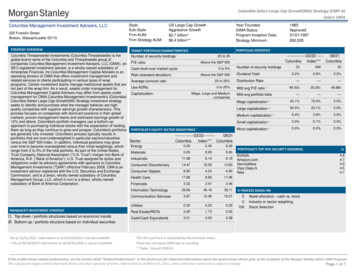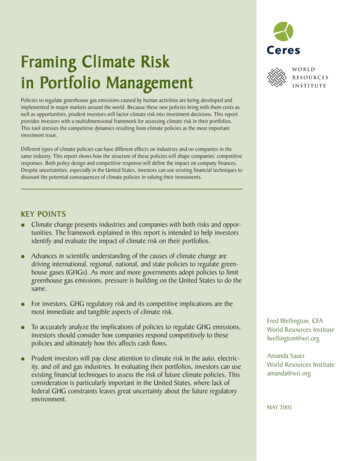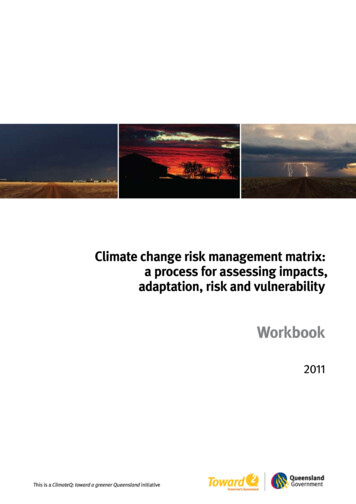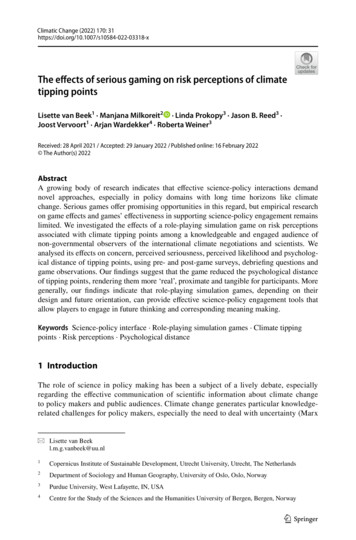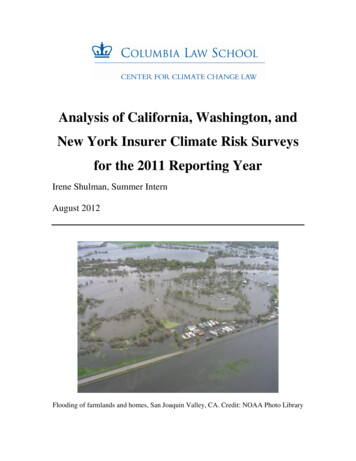
Transcription
Analysis of California, Washington, andNew York Insurer Climate Risk Surveysfor the 2011 Reporting YearIrene Shulman, Summer InternAugust 2012Flooding of farmlands and homes, San Joaquin Valley, CA. Credit: NOAA Photo Library
Background on Climate Risk Surveys for Reporting Year 2011In 2009, the National Association of Insurance Commissioners (NAIC) Climate ChangeTask Force adopted the Insurer Climate Risk Disclosure Survey in order to address theimplications of climate change for the insurance industry. The Climate Change TaskForce originally intended to require all insurance companies with written premiums over 500 million to file a public survey report. Due to liability and confidentiality concerns,the survey was instead adopted as voluntary and confidential. In 2010, twenty-one statesindicated to the NAIC that they would administer the voluntary survey, but when theClimate Change Task Force dissolved in 2011, few jurisdictions continued to administerthe surveyIn February 2012, the New York Department of Financial Services, the Washington StateOffice of the Insurance Commissioner, and the California Department of Insuranceannounced that they would require insurers to participate in NAIC’s survey for the 2011reporting year. The three states changed the conditions, requiring insurers that write inexcess of 300 million in premiums annually to respond.This summary reviews the climate risk surveys submitted by insurance companies toCalifornia, New York, and Washington. Some of the insurers that submitted surveysoperate exclusively on regional levels, while others provide national or internationalservices. Swiss Re Group is the only reinsurance company that submitted a survey. Allsurveys for the 2011 reporting year were submitted to the California Department ofInsurance, the New York Department of Financial Services, or the Washington StateOffice of the Insurance Commissioner on May 7, 20121.Insurance companies that were required by more than one of the three states to submitsurveys submitted the same survey to each state. Among the companies that voluntarilysubmitted surveys for the 2010 reporting year, many provided more lengthy, detailedanswers in the 2011 mandatory surveys than in 2010. Several insurers also submittedattachments with the surveys, providing more detail for their responses.The Carbon Disclosure Project (CDP) is a non-profit that pursues disclosure statementsabout GHG emissions and climate change risk from companies throughout the worldincluding many insurance companies. Many insurance companies that have completedthe CDP questionnaire referenced it as supplemental information when completing theNAIC climate risk survey. In some cases, companies simply reused answers from theCDP survey.1Completed surveys are available on the California Department of Insurance ices-forms/annualnotices/ClimateSurvey.cfm. See Appendix 2 for a list of insurers thatparticipated2
Answers were varied across companies. In some cases, differences were due to thedifference in services provided by the companies. Namely, the effects of climate changeon insurance companies are different from those on providers of health insurance, lifeinsurance, property insurance, casualty insurance, and automobile insurance. In othercases, there were regional differences, as climate change is not expected to impact allregions equally. More companies in the West considered the risk of environmentalcatastrophe than in New York, likely due to the fact that severe weather events such aswildfire and drought are less likely in New York. Other differences were related tocompany size.Of the 400 surveys available to the public on the California Department of Insurancewebsite, 264 indicated that climate change poses some risk to the insurance company.Among companies that expanded on these risks, 174 identified increased hurricanefrequency or severity, which was the most common threat discussed in the surveys. 87companies identified regulatory risks related to climate change.Everest National Insurance Company is the only insurer that declined to complete anypart of the survey. It stated that the information required to complete the survey “isconfidential and if made public, could cause irreparable harm to Everest’s business.” Thecompany also stated that the “vague and ambiguous” nature of the survey in its failure todefine “climate change related risks” or “climate change influenced events” made itimpossible for Everest to provide a response.Emissions reductions in company operationsOverall, the discussion of measures to reduce company GHG emissions was longer, moredetailed, and contained more specific quantitative information than any other area ofdiscussion in the survey.Nearly all of the insurance companies reported that they either have reduced or plan toreduce GHG emissions in their operations. Of those companies, most described efforts toreduce their automobile fleets, rely more heavily on “paperless” communication, andencourage employees to use public transportation. Some companies have moved theiroperations to LEED certified office buildings. Many insurance companies providedquantitative information reflecting how much their actions have reduced or will reduceGHG intensity and resource consumption. Allstate Insurance Group provided aparticularly detailed response and is the only company that discussed specific reductiontargets for the future. It indicated a 20% energy reduction goal by 2020 compared with2007. 2 No other company discussed an emissions target, and Aetna stated that doing sowould not be practical “given the evolving regulatory environment, variability in energycosts, the evolution of our business, and the countries in which we operate.”323See Appendix 7 for Allstate’s complete reportSee Appendix 8 for excerpts from Aetna’s report3
In general, larger companies reported more extreme measures to reduce emissions thansmall companies. This may be due to their financial resources, as larger companies havethe capital to invest in expensive projects, such as LEED buildings. Ownership of officebuildings may also be a factor, as companies that lease office spaces have less controlover building utilities. For example, among the few companies that reported that theyhave not taken measures to reduce GHG intensity was Health Net Life InsuranceCompany. It explained, “99% of all Health Net facilities are under a gross lease structurewherein our Landlords completely control the emission producing equipment andoperations.”4Mercury Casualty Company responded “No” to this section of the survey withoutproviding an explanation.Emissions reductions for policyholdersThe survey inquired about measures to reduce the GHG emissions of policyholders, andanswers for this section of the survey were shorter and more general than the previoussection about reductions in company operations.Most insurers reported that they have taken measures to reduce policyholder emissions.Many reported encouragement of “paperless” communications and statements, ordiscounts for policyholders who implement mitigation measures. Certain automobileinsurers reported benefits to policyholders with hybrid vehicles. Certain property insurersreported that they offer endorsements to cover the cost of repairs or rebuilding with greenmaterials. Very few companies gave quantitative information regarding the success ofsuch efforts and how much emissions have been reduced as a result. Blue Shield ofCalifornia reported a 54% reduction in the amount of paper printed for communicationwith policyholders.Risks of climate changeCompanies were asked to identify risks that climate change poses to their businesses.Answers varied in length from one sentence to one page. Some companies asserted thatclimate change poses no threat, neither operationally, nor financially, and gave noexplanation. Health Net Life Insurance Company answered “none” and stated that its riskassessment team “did not identify climate change as a material risk to any of our criticalfacilities to cause us to include climate change as a risk.” No further detail was offered.Of the 400 companies, 264 reported that there are risks associated with climate change.Some addressed direct risks including droughts, wildfire, floods, hurricanes, windstorms,and incidence of cardiovascular disease and asthma. Increased hurricane frequency orintensity was singled out as the most established threat by 174 companies. Othercompanies discussed indirect risks of climate change related to resource availability andpotential regulatory risks from insurance regulatory obligations, emissions caps, or4See Appendix 8 for complete Health Net Life Insurance Company report4
building code requirements. Regulatory risks were the second most common concern andwere addressed by 87 companies. Although insurance companies do not generateproducts or services that require substantial emissions of GHGs, they expect to beimpacted by absorbing the increased cost that utility companies will face. Farmers Groupacknowledged the complexity of identifying regulatory risks specifically for insurancecompanies that cover multiple regions, stating, “Results of the same policy will likely bedifferent when applied in different jurisdictions compliance in one jurisdiction may notsatisfy other jurisdictions, thus creating duplicative or additive expenditures in thedevelopment of adaptive risk management solutions without demonstrable economic orsocial benefit.”Although several insurance companies provided lengthy answers to this section of thesurvey and addressed several risks associated with climate change, none of the insurersgave a quantitative assessment of the risks they mentioned or of the financial impacts thatsuch risks may have. The only insurer to give quantitative information in this section wasthe Allianz Group Insurance Companies. Allianz stated that it has experienced a “fifteenfold increase in weather-related insurance claims over the last 30 years,” and that in itsglobal industrial insurance business “40 percent of damages are due to naturalcatastrophes.” Allianz also provided quantitative predictions, stating “Over the nextdecade, Allianz estimates average losses for the insurance industry could grow to US 41billion per annum.”5A few insurers declined to answer whether or not they anticipate risks related to climatechange. Some simply asserted that the question is not applicable. State Farm answeredthat it “is not aware of an industry standard that defines a climate risk, climate change orclimate change-related risk,” and without such standards and definitions, State Farmasserted that it has no basis to account for climate change or make predictions about risksthat climate change may pose.6Fidelity National Indemnity Insurance Company was the only insurer that discussedbenefits related to climate change. The company stated, “Due to the nature of theNational Flood Insurance Program, any increased flooding as a result of climate changelikely would have a positive impact on the company’s business.”Changes to risk management policies and investment portfoliosMost companies acknowledged that they face potential risks associated with climatechange (see above) and indicated that climate change is considered by their riskmanagement and investment teams. However, they all reported that after consideration ofsuch risks, it was determined that company strategies and investment portfolios shouldnot be altered in response to climate change. Reasons for this varied. Some companiesexplained that the risks associated with climate change were not significant enough,5See Appendix 4 for Allianz Group Insurance Company complete answer to surveyquestions #46See Appendix 6 for complete State Farm report5
while others explained that risks are not discretely identifiable and measurable, making itimpossible to explicitly structure investments reflecting environmental factors. Aetnareported that it regards climate change as distant and gradual, affording flexibility torespond when the risks become more certain. Farmers Group stated its view that climatefactors would drive long-term economic value for society, and thus, be reflected in thevalue of investments available in capital markets without explicit investment adjustments.Allstate and MetLife mentioned that although their investment strategies wereunchanged, their normal investment portfolios include investments in alternative energy.No quantitative information regarding these investments was given.Actions taken to manage the risk of climate changeNo insurance company explicitly indicated that it had changed policy rates as a result ofclimate change factors at this point, though some discussed in general the potential needto do so in the future.Insurers reported a variety of other actions taken to manage the risks posed by climatechange. Certain companies described methods for coping in the event of a naturaldisaster, and very generally referenced emergency business continuity plans. Othercompanies described plans to reduce resource intensive practices in their daily operations,thereby reducing the financial risks associated with resource and utility pricing due toclimate change (see above).Most companies, particularly providers of property insurance, reported the use ofcomputer models to assess the risks of climate change, though most did not provide detailbeyond this. AAA Northern California, Nevada and Utah Insurance Exchange reportedthat it has adjusted its computer models to utilize greater hurricane frequencies, “asopposed to the historical record of activity,” as well as “a warm sea-surface temperatureeven set.” Some insurance companies indicated that they do not use computer models atall. These were mostly providers of health and life insurance.In taking action to manage the risk of climate change, several companies also reportedthat they are involved with organizations that have interests that overlap with those ofadvocates of climate change mitigation. Some also participate directly in “green”organizations, while others support environmental legislation and research in alternativeenergy through their philanthropy divisions.ConclusionsThe majority of insurance companies do view climate change as a threat to theirbusinesses, though for the most part the companies did not elaborate on those threats.Few companies provided detail on how they plan to cope with the risks of climatechange, and no company indicated changes in policy rates. Overall, statements related toclimate change risks, climate change policy, and climate change management were notvery specific or informative. The sections that did contain detail and quantitative6
information were those discussing company efforts to mitigate their resourceconsumption and carbon footprints.The reason that the meaningful areas of the survey lacked thorough answers may be dueto the public availability of the responses. Insurance companies may be concerned thatthe information they provide will affect claims or competition with other insurers.Additionally, the guidelines that California Department of Insurance issued for the surveydid not encourage thorough answers. The guidelines indicated that insurers are notrequired to provide “quantitative or forward-looking information.” They also allow aninsurance company to “state that a question is not relevant to its business practice,operations or investments.”7 Perhaps such leeway should not be given, and the responsesshould be confidential. Lastly, the survey guidelines should provide definitions of climatechange and climate change risks, so that insurers may not decline to answer for lack of aclear definition.The survey guidelines strongly steered companies toward discussing harmful risksassociated with climate change. Fidelity National Indemnity Insurance Company’sstatement that climate change will likely have a positive impact on company businesssuggests that the survey should include questions and guidelines that encourage insurersto discuss the potential benefits of climate change.7For complete set of guidelines see ms/annualnotices/ClimateSurvey.cfm7
Contents of AppendicesNote: The survey excerpts that are included as appendices were selected for theirnoteworthy or anomalous responses, and the majority are discussed in the text above.Some are included as examples of particularly thorough or particularly lacking reports.Appendix 1: Climate Risk Survey Form Administered to Insurance Companies forthe 2011 Reporting Year 8Appendix 2: Insurers that Participated in the Survey . .9Appendix 3: Everest National Insurance Company Report. .29Everest is the only insurer that did not complete any part of the survey, stating that theinformation involved is confidential, and that the survey’s failure to define climatechange makes it impossible to answer.Appendix 4: Allianz Group Insurance Companies Report, Reponse to Question #4 .30Allianz was the only insurer to provide quantitative information regarding losses related toclimate change.Appendix 5: Amica Mutual Group Report, Response to Question #4 33Amica’s response to question 4 of the survey serves as an example of a typical answer.The response is complete and addresses the question, but is brief and provides littledetail.Appendix 6: State Farm Insurance Company Report .34State Farm declined to respond to several survey questions, stating that there is nostandard definition of climate change as its reason.Appendix 7: Allstate Insurance Group Report .37Allstate serves as an example of a particularly thorough reportAppendix 8: Health Net Life Insurance Company Report .44Among the companies that stated that climate change poses no risks to their businesses,Health Net Life’s response was common. It provided little detail beyond its response thatthere is no risk.Appendix 9: Excerpts From Aetna Life Insurance Company Report 46Aetna provided a particularly thorough response, and is also noted for its response inquestion 1 that setting emissions targets is not practical.Appendix 10: MetLife Insurance Company report 52MetLife’s report is an example of common survey responses.Appendix 11: Mercury Casualty Company report .55Mercury’s report is an example of a particularly lacking response.8
Appendix 1: Climate Risk Survey Form Administered to Insurance Companies forthe 2011 Reporting YearINSURER CLIMATE RISK SURVEYCompany Name:NAIC No.:Nationwide Direct Premiums Written:Group No.:Survey Questions1. Does the company have a plan to assess, reduce or mitigate itsemissions in its operations or organizations? If yes, pleasesummarize.2. Does the company have a climate change policy with respect torisk management and investment management? If yes, pleasesummarize. If no, how do you account for climate change in yourrisk management?3. Describe your company’s process for identifying climate changerelated risks and assessing the degree that they could affect yourbusiness, including financial implications.4. Summarize the current or anticipated risks that climate changeposes to your company. Explain the ways that these risks couldaffect your business. Include identification of the geographical areasaffected by these risks.5. Has the company considered the impact of climate change on itsinvestment portfolio? Has it altered its investment strategy inresponse to these considerations? If so, please summarize steps youhave taken.6. Summarize steps the company has taken to encouragepolicyholders to reduce the losses caused by climate changeinfluenced events.7. Discuss steps, if any, the company has taken to engage keyconstituencies on the topic of climate change.8. Describe actions your company is taking to manage the risksclimate change poses to your business including, in general terms,the use of computer modeling.Comparable Carbon DisclosureProject QuestionsPerformance Question 21Risks and OpportunitiesQuestions 1-3Risks and OpportunitiesQuestions 1-3Risks and OpportunitiesQuestion 3: “Other Risks”Question 6: “Other Opportunities”Risks and OpportunitiesQuestions 4-6GovernanceQuestions 24, 26, 27Risks and OpportunitiesQuestions 1-39
Appendix 2: Insurers that Participated in the SurveyAETNAFEDERATED MUTUALGROUPAMERICANINTERNATIONAL GROUP,INC.ASSURANT INCAMICA MUTUAL GROUPBERKSHIRE HATHAWAYGROUPCHUBB GROUP OFINSURANCE COMPANIESAVIVA USAFM GLOBAL GROUPGREAT AMERICANINSURANCE COMPANYTHE HANOVERINSURANCE GROUPTHE HARTFORDINSURANCE GROUPMGICNATIONWIDE MUTUALINSURANCE COMPANYPROGRESSIVEINSURANCE GROUPSWISS RE GROUPASSURED GUARANTYZURICH US INSURANCEPOOL GROUPERIE INSURANCE GROUPING AMERICAINSURANCE HOLDINGSINCVERMONT MUTUALINSURANCE GROUPSELECTIVE INSURANCEGROUP, INC.THE CINCINNATIINSURANCE GROUPMUTUAL OF OMAHAINSURANCE COMPANYTHE PRUDENTIAL10
GROUPTHE PHOENIX LIFEINSURANCE COMPANYTHE GUARDIAN LIFEINSURANCE COMPANYOF AMERICAMASSACHUSETTSMUTUAL LIFEINSURANCE COMPANYUNUM GROUPPHILADELPHIACONSOLIDATEDHOLDING GROUPUNITED HEALTH GROUP,INC.RLI GROUPNEW YORK LIFETHE PENN MUTUAL LIFEGROUPNORTHWESTERNMUTUAL GROUPJOHN HANCOCK GROUPAXA GROUPHIP INSURANCE GROUPSYMETRA FINANCIALEXCELLUS HEALTHPLAN INC D.B.A.EXCELLUS BLUECROSSBLUESHIELD ANDUNIVERA HEALTHCAREMVP HEALTH CARETHE TIAA FAMILY OFCOMPANIESCALIFORNIA STATEAUTO GROUPARCH INSURANCEGROUPEMBLEMHEALTH INCTHE STANDARDNYCM INSURANCEGROUPGMAC INSURANCETRAVELERS GROUP11
21ST CENTURYCENTENNIALINSURANCE COMPANY21ST CENTURYINSURANCE COMPANYAAA LIFE INSURANCECOMPANYACCENDO INSURANCECOMPANYACCIDENT FUND INS COOF AMERACCIDENT FUNDINSURANCE COMPANYOF AMERICAACE AMERICANINSURANCE COMPANYACE PROPERTY ANDCASUALTY INSURANCECOMPANYACUITY A MUT INS COAETNA LIFE INSURANCECOMPANYAGCS MARINEINSURANCE COMPANYALFA MUT INS COALLIANZ GLOBAL RISKSUS INSURANCECOMPANYALLIANZ LIFEINSURANCE COMPANYOF NORTH AMERICAALLIENZ LIFEINSURANCE COMPANYOF NEW YORKALLSTATE CNTY MUTINS COALLSTATE FIRE & CASINS COALLSTATE IND COALLSTATE INDEMNITYCOMPANYALLSTATE INS COALLSTATE INSURANCECOMPANYALLSTATE LIFE INS CO12
ALLSTATE NJ INS COALLSTATE PROP & CASINS COALLSTATE PROPERTYAND CASUALTYINSURANCE COMPANYALLSTATE TX LLOYDSAMERICAN AGRIBUSINESS ATIONAMERICANAUTOMOBILEINSURANCE COMPANYAMERICAN BANKERSINSURANCE COMPANYOF FLORIDAAMERICAN CASUALTYCOMPANY OF READING,PENNSYLVANIAAMERICAN FAMILY LIFEASSURANCE CO. OF NEWYORKAMERICAN FAMILY LIFEINS COAMERICAN FAMILY MUTINS COAMERICAN GUARANTEEAND LIABILITYINSURANCE COMPANYAMERICAN HERITAGELIFE INS COAMERICAN INCOME LIFEINSURANCE COMPANYAMERICAN INSURANCECOMPANY (THE)AMERICAN MODERNHOME INSURANCECOMPANYAMERICAN NATIONALINSURANCE COMPANY13
AMERICAN NATIONALPROPERTY ANDCASUALTY COMPANYAMERICAN SECURITYINSURANCE COMPANYAMERICAN STATESINSURANCE COMPANYAMERICAN UNITED LIFEINSURANCE COMPANYAMERICAN ZURICHINSURANCE COMPANYAMERICO FINANCIALLIFE AND ANNUITYINSURANCE COMPANYAMERITAS LIFEINSURANCE CORP.ANNUITY INVESTORSLIFE INSURANCECOMPANYANTHEM BLUE CROSSLIFE AND HEALTHINSURANCE COMPANYATHENE ANNUITY &LIFE ASSURANCECOMPANYAUTO OWNERS INS COAUTOMOBILE CLUBINSURANCEASSOCIATIONAVIVA LIFE ANDANNUITY COMPANYAXIS INS COAXIS INSURANCECOMPANYBALBOA INSURANCECOMPANYBANKERS LIFE ANDCASUALTY COMPANYBANKERS STANDARDINSURANCE COMPANYBANNER LIFEINSURANCE COMPANYBLUE SHIELD OFCALIFORNIA LIFE &HEALTH INSURANCE14
COMPANYC.M. LIFE INSURANCECOMPANYCENTRAL MUTUALINSURANCE COMPANYCHICAGO TITLEINSURANCE COMPANYCIGNA HEALTH ANDLIFE INSURANCECOMPANY INCCIGNA LIFE INSURANCECOMPANY OF NEWYORK INCCINCINNATI INS COCINCINNATI INSURANCECOMPANY (THE)CITIZENS INS CO OFAMERCITIZENS INSURANCECOMPANY OF AMERICACM LIFE INS COCNO INSURANCECOMPANIESCOAST NATIONALINSURANCE COMPANYCOLONIAL LIFE &ACCIDENT INSURANCECOMPANYCOLONIAL PENN LIFEINSURANCE COMPANYCOLUMBIA CASUALTYCOMPANYCOMMERCE INS COCOMMONWEALTH LANDTITLE INSURANCECOMPANYCOMPANION LIFEINSURANCE COMPANYCOMPANION PROPERTYAND CASUALTYINSURANCE COMPANYCONNECTICUT GENERALLIFE INSURANCECOMPANY15
CONNECTICUT GENERALLIFE INSURANCECOMPANY TY COMPANYCONTINENTALINSURANCE COMPANY(THE)CONTINENTAL WESTERNINSURANCE COMPANYCOUNTRY LIFEINSURANCE COMPANYCOUNTRY MUTUALINSURANCE COMPANYCOUNTRY PREFERREDINSURANCE COMPANYCUMIS INSURANCESOCIETY, INC.CUNA MUTUALINSURANCE SOCIETYDELTA DENTALINSURANCE COMPANYDELTA DENTALINSURANCE COMPANYDOCTORS' COMPANY,AN INTERINSURANCEEXCHANGE (THE)ELECTRIC INS COELECTRIC INSURANCECOMPANYEMPIRE FIRE ANDMARINE INSURANCECOMPANYEMPLOYERS MUTUALCASUALTY COMPANYENCOMPASS IND COENCOMPASS INS CO OFAMEREQUITRUST LIFEINSURANCE COMPANYESURANCE INS COESURANCE INSURANCE16
COMPANYESURANCE PROPERTYAND CASUALTYINSURANCE COMPANYEVEREST NATIONALINSURANCE COMPANYFARM BUREAU LIFE INSCOFARM BUREAU PROP &CAS INS COFARM FAMILYCASUALTY INSURANCECOMPANYFARMERS INSURANCECOMPANY OF OREGONFARMERS INSURANCECOMPANY OFWASHINGTONFARMERS INSURANCECOMPANY, INC.FARMERS INSURANCEEXCHANGEFARMINGTONCASUALTY COMPANYFIDELITY AND DEPOSITCOMPANY OFMARYLANDFIDELITY ANDGUARANTY INSURANCEUNDERWRITERS, INC.FIDELITY NATIONALTITLE INSURANCECOMPANYFIDELITY NATL IND INSCOFINANCIAL PACIFICINSURANCE COMPANYFIRE INSURANCEEXCHANGEFIREMAN'S FUNDINSURANCE COMPANYFIRST AMERICAN TITLEINSURANCE COMPANYFIRST HLTH LIFE & HLTHINS CO17
FIRST LIBERTY INS CORPFIRST LIBERTYINSURANCECORPORATION (THE)FIRST NATIONALINSURANCE COMPANYOF AMERICAFIRST UNUM LIFEINSURANCE COMPANYFIRST UNUM LIFEINSURANCE COMPANYFOREMOST INSURANCECOMPANY GRANDRAPIDS, MICHIGANFRANKENMUTH MUT INSCOGARRISON PROPERTYAND CASUALTYINSURANCE COMPANYGENERAL AMER LIFE INSCOGENERAL AMERICANLIFE INSURANCECOMPANYGENERAL CASUALTYCOMPANY OFWISCONSINGENWORTH LIFE ANDANNUITY INSURANCECOMPANYGENWORTH LIFEINSURANCE COMPANYGENWORTH LIFEINSURANCE COMPANYOF NYGERBER LIFE INS COGERBER LIFEINSURANCE COMPANYGLOBE LIFE ANDACCIDENT INSURANCECOMPANYGREAT AMERICANASSURANCE COMPANYGREAT AMERICANINSURANCE COMPANY18
GREAT AMERICANINSURANCE COMPANYOF NEW YORKGREAT AMERICAN LIFEINSURANCE COMPANYGREAT WEST CASUALTYCOMPANYGREENWICH INS COGREENWICH INSURANCECOMPANYGROUP HLTH COOPGROUP HLTH OPTIONSINCHANOVER INS COHANOVER INSURANCECOMPANY (THE)HARTFORD ACCIDENTAND INDEMNITYCOMPANYHARTFORD CASUALTYINSURANCE COMPANYHARTFORD FIREINSURANCE COMPANYHARTFORD INSURANCECOMPANY OF THEMIDWESTHARTFORD LIFE ANDACCIDENT INSURANCECOMPANYHARTFORD LIFE ANDANNUITY INSURANCECOMPANYHARTFORD LIFEINSURANCE COMPANYHARTFORDUNDERWRITERSINSURANCE COMPANYHCC LIFE INSURANCECOMPANYHEALTH NET LIFEINSURANCE COMPANYHM LIFE INSURANCECOMPANYHOMESTEADERS LIFECOMPANY19
HORACE MANN LIFEINSURANCE COMPANYHUDSON INSURANCECOMPANYHUMANA INSURANCECOMPANYIDS PROPERTYCASUALTY INSURANCECOMPANYILLINOIS FARMERSINSURANCE COMPANYINDEMNITY INSURANCECOMPANY OF NORTHAMERICAINFINITY INSURANCECOMPANYING LIFE INSURANCEAND ANNUITYCOMPANYING USA ANNUITY ANDLIFE INSURANCECOMPANYINTEGRITY LIFEINSURANCE COMPANYINTERINSURANCEEXCHANGE OF THEAUTOMOBILE CLUBJACKSON NATIONALLIFE INSURANCECOMPANYJEFFERSON NATIONALLIFE INSURANCECOMPANYJOHN DEERE INSURANCECOMPANYKAISER FOUND HLTHPLAN OF THE NWKEMPER INDEPENDENCEINSURANCE COMPANYKEMPER INDEPENDENCEINSURANCE COMPANYLAFAYETTE LIFEINSURANCE COMPANY(THE)LIBERTY INS CORP20
LIBERTY INSUNDERWRITERS INCLIBERTY INSURANCECORPORATIONLIBERTY INSURANCEUNDERWRITERS, INC.LIBERTY LIFE INS COLIBERTY MUT FIRE INSCOLIBERTY MUT INS COLIBERTY MUTUAL FIREINSURANCE COMPANYLIBERTY MUTUALINSURANCE COMPANYLIBERTY NATIONAL LIFEINSURANCE COMPANYLIFE INSURANCECOMPANY OF THESOUTHWESTLINCOLN BENEFIT LIFECOLINCOLN HERITAGE LIFEINSURANCE COMPANYLINCOLN LIFE &ANNUITY COMPANY OFNEW YORKLINCOLN LIFE ANDANNUITY COMPANY OFNEW YORKLINCOLN NATIONALLIFE INSURANCECOMPANY (THE)LM INS CORPLM INSURANCECORPORATIONMARKEL INSURANCECOMPANYMARYLAND CASUALTYCOMPANYMASSACHUSETTS BAYINS COMASSACHUSETTS BAYINSURANCE COMPANYMASSACHUSETTS MUTLIFE INS CO21
MASSACHUSETTSMUTUAL LIFEINSURANCE COMPANYMEDICAL PROTECTIVECOMEDICAL PROTECTIVECOMPANY (THE)MERCURY CASUALTYCOMPANYMERITPLAN INSURANCECOMPANYMETLIFE INS CO OF CTMETLIFE INSURANCECOMPANY OFCONNECTICUTMETLIFE INVESTORSINSURANCE COMPANYMETLIFE INVESTORSUSA INS COMETLIFE INVESTORSUSA INSURANCECOMPANYMETROPOLITAN LIFE INSCOMETROPOLITAN LIFEINSURANCE COMPANYMID-CENTURYINSURANCE COMPANYMINNESOTA LIFEINSURANCE COMPANYMORTGAGE GUARANTYINSURANCECORPORATIONMUTUAL OF AMER LIFEINS COMUTUAL OF AMERICALIFE INSURANCECOMPANYMUTUAL OF ENUMCLAWINS CONATIONAL FIREINSURANCE COMPANYOF HARTFORDNATIONAL INTEGRITYLIFE INSURANCE22
COMPANYNATIONAL INTERSTATEINSURANCE COMPANYNATIONAL LIFEINSURANCE COMPANYNATIONAL SURETYCORPORATIONNATIONAL WESTERNLIFE INSURANCECOMPANYNAU COUNTRYINSURANCE COMPANYNAVIGATORS INS CONAVIGATORSINSURANCE COMPANYNETHERLANDS INS COTHENETHERLANDSINSURANCE COMPANY(THE)NEW ENGLAND LIFE INSCONEW ENGLAND LIFEINSURANCE COMPANYNEW JERSEYMANUFACTURERS INSCONEWPORT INSURANCECOMPANYNGM INS CONORTHLANDINSURANCE COMPANYOCCIDENTAL FIRE &CASUALTY COMPANYOF NORTH CAROLINAOHIO CAS INS COOHIO CASUALTYINSURANCE COMPANY(THE)OLD REPUBLICINSURANCE COMPANYOLD REPUBLICNATIONAL TITLEINSURANCE COMPANY23
ONEBEACON AMER INSCOPACIFIC LIFE & ANNUITYCOMPANYPACIFIC LIFEINSURANCE COMPANYPACIFICSOURCE HLTHPLANSPAUL REVERE LIFEINSURANCE COMPANY(THE)PEERLESS IND INS COPEERLESS INDEMNITYINSURANCE COMPANYPEERLESS INS COPEERLESS INSURANCECOMPANYPENNSYLVANIA LIFEINSURANCE NCE COMPANYPHILADELPHIAINDEMNITY INSURANCECOMPANYPHOENIX LIFEINSURANCE COMPANYPHYSICIANS RECIPINSURERSPMI MORTGAGEINSURANCE CO.PRAETORIANINSURANCE COMPANYPREMERA BLUE CROSSPRIMERICA LIFEINSURANCE COMPANYPRINCIPAL LIFE INS COPRINCIPAL LIFEINSURANCE COMPANYPRODUCERSAGRICULTUREINSURANCE COMPANY24
PROPERTY ANDCASUALTY INSURANCECOMPANY OFHARTFORDPROTECTIVE LIFEINSURANCE COMPANYPROVIDENCE HLTHPLANPROVIDENT LIFE ANDACCIDENT INSURANCECOMPANYP
In 2009, the National Association of Insurance Commissioners (NAIC) Climate Change Task Force adopted the Insurer Climate Risk Disclosure Survey in order to address the implications of climate change for the insurance industry. The Climate Change Task Force originally intended to require all insurance companies with written premiums over
